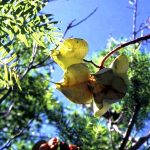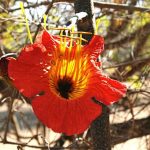TREE LIFE
September 1987
MASHONALAND CALENDAR
Tuesday September 1st : Botanic Garden Walk. Meet at the Car park at 1645 for 1700hours.
Sunday September 20th : An outing to Middleton Farm, Ruwa, the home of Bill and Margaret Hughes. An area of undeveloped woodland/baboon country promises an interesting day not too far from the city. Bring lunch. No bus arranged this time. Instead, meet at the farm at 0945 hours.
Saturday September 25th : Meeting at Mukuvisi Woodlands. Meet at 1430 at the corner Paget Road/Inyanga Crescent.
MATABELELAND CALENDAR
On Sunday September 6th we will go to the Area East of Burnside. Meet at the Eastern end of Southway at 0830 hours.
On Sunday August 2nd we went to the farm of Mr. and Mrs. Mitchell, Claremont, the part known as Redhill.
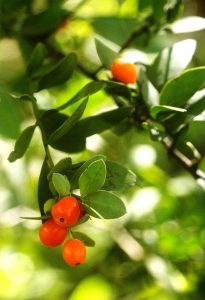
Osyris lanceolata. Photo: Bart Wursten. Source: Flora of Zimbabwe
Firstly we parked under some very large trees, mainly Australian Bottle Trees, apparently Brachychiton rupestre, some with fine straight boles and some definitely bottled. There were also some very large and old Jacaranda and Beefwood. They seem to have been planted in the early 1900’s and are most impressive.
We then identified some 60 indigenous trees in the area and down to the river, which has water. It was dry, but just now has come up again. This, I think, happens more often than is generally realized. There were some interesting Acacia, many Acacia karroo, A.nigrescens, A.rehmanniana, A.robusta, A.tortilis, Boscia angustifolia, Canthium lacescens, Catha edulis, Celtis africana, Combretum erythrophyllum, Combretum molle, Dovyalis zeyheri, Ehretia rigida, Euclea undulata, Faurea saligna, Ficus sur, Mimusops zeyheri, Mundulea sericea, Ochna pulchra, Osyris lanceolata, Protea gaguedi, Rhus pyroides, Rhus tenuinervis, Schrebera alata with prominent wooden pears, an undamaged Securidaca longepedunculata, violet tree which is unusual here as most get cut about for medicine, Steganotaenia araliacea, Tapiphyllum velutinum, Tarchonanthus camporatus, Terminalia mollis, Terminalia trichopoda, Ziziphus mucronata.
-C.Sykes
OUTING TO SERUI DRIFT FARM, CHEGUTU, 16TH AUGUST 1987
This out saw the launching of the Ten Tree Group. The object of this group is to introduce beginners to the pleasure of knowing about trees by examining at a leisurely pace, and in some depth, a limited number of trees. It is hoped that after attending four or five outings with this group, beginners will feel equipped to benefit from the expert knowledge available within the Society but which, on initial acquaintance, is slightly overwhelming in its breadth.
We followed the wanderings of a mythical traveler in the book who made the mistake of trying to cross a river on a log of Colophospermum mopane, only to find that this tree sinks rather than floats. Having drunk a good bit of water the traveler worries that he might have picked up bilharzias, but finds some fruit of Balanites aegyptiaca which is alleged to sort out spleen and liver problems. Feeling somewhat hungry he finds some ripe pods of Bauhinia thonningii, pounds up the seeds, and makes himself some cookies.
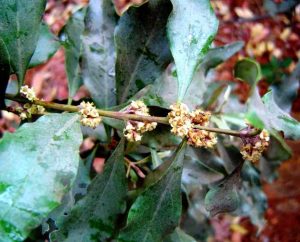
Euclea divinorum. Photo: Bart Wursten. Source: Flora of Zimbabwe
On his way once more, he starts worrying about snakes, but possesses himself of a root of Acacia polyacantha, which is alleged to repel them and crocodiles as well. Now things start going wrong. One of his teeth start to ache, but he alleviates this by chewing some leaves of Dichrostachys cinerea. Something that he has eaten is causing a king sized stomach ache, so he tries eating some fruit of Euclea divinorum, which makes him wish that he hadn’t. Feeling thirsty he finds a mucky little pool but precipitates the impurities by rubbing the inside of his mug with the fruit of Strychnos potatorum. Mending a hole in his tacky with some gum from Acacia karroo, he finds refuge in a hut which he takes the precaution of protecting from lightning by inserting a branch of Gardenia ternifolia in the roof. He falls asleep dreaming of a mug of beer made from the fruit of Rhus lancea, but it remains a dream as he, like the writer, only found this tree at the last minute.
SERUI DRIFT : 16TH August 1987
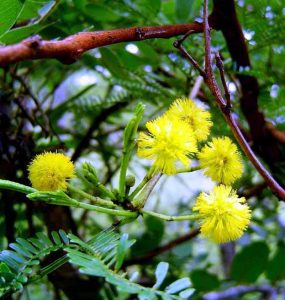
Acacia karroo. Photo; Bart Wursten. Source: Flora of Zimbabwe
Chegutu Nuts were happy to join the Harare branch on the banks of the Saruwe river, for what proved to be a full day. The farm, Serui Drift, belonging to Mr. W. Brymer has soils varying from stony red to alluvial to sandveld and dyke like, the latter predominating in the area where we met, and the variety of trees is correspondingly great. Those members who felt less confident of absorbing the wide range of trees joined our chairman to test his “study 10 trees chats” plan, and have spoken enthusiastically of their morning. The rest of us set off to tackle Acacias which were plentiful and varied. Firstly Acacia gerardii presented itself, we were told some easy tips for identification, the grey covering the ends of the twigs cracking to reveal pinky under bark; the pods almost G shaped and finely grey hairy- many we saw had split on the tree and seeds hung out like jewels on a collar, and the leaf growth clustering close along the branches. Nearby Acacia karroo raised a “mufushwa” head, its dark bark cracking to show rusty red underneath, and its slightly bumpy, curved pods saving us from having to count leaflets. Both of these bear long straight thorns, as do A.nilotica and A.rehmanniana. We were to see an A.nilotica fallen over so that we could note how the branches tend to bend back into the umbrella of the tree to give it the truly tangled look which is so characteristic. The pods, straight and closely constricted between seeds to look like pop on beads, give the tree its common name, “scented thorn” and when green they are apple scented. Acacia rehmanniana is easy to distinguish with yellow grey hairy twigs rubbing to red, and red branches and its leaves distinctive in densely fine neat precision. And then the hooked thorns were there, Acacia polyacantha, the often stately, layered looking white thorn, with creamy flaky bark and large bosses along the trunk and branches where originally thorns had grown. Acacia goetzei, also bearing curved prickles developing into large bossed thorns as the tree ages, seemed to have tall straight trunks with somewhat spindly straggling branches, and the leaflets, much larger than most acacias. One tree we saw there had leaflets almost fingernail size. And lastly, who can forget the fine stand of Acacia galpinii, tall, upright trees with plentiful hooked prickles and masses of long straight pinky brown pods.
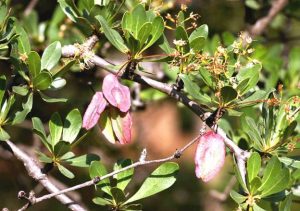
Terminalia randii. Photo: Bart Wursten. Source: Flora of Zimbabwe
Bolusthanthus speciosus everywhere were still in full green leaf and often still bearing the flat pods from last season. Whilst the books list this tree as having blue to mauve flowers, it is in this area of the Saruwa that we have seen one with creamy white flowers, also one below the Suri suri dam, and another near our farm turn off on the Seigneury road. Pittosporum viridiflorum with a floppy tired look leant over the river, with only the calyces of the fruit to be seen on most, but one tree still offering sticky red seeds to the birds. A highlight for us all was Terminalia randii, a Zambezi Valley intruder with its small leaves clustered on short knobby spurs along the branches and a pair of long spines at each knob, and yes, the leaves were turning from silvery green to maroon and purple, and the bark “anastamosing” in Terminalia fashion, looking like magnified stretch knit fabric. This also showed on a nearby T.stenostachys, its large leaves frost burnt, and the Terminalia sericea almost leafless but carrying the typical rounded fruit like galls. Fresh in leaf on the river bank were Salix subserrata with partially toothed, white backed, alternate leaves and pink petioles, Nuxia oppositifolia, its leaves opposite, less finely serrate, and slightly sticky, and Rhus quartiniana with trifoliolate, aromatic clear green leaves, the river Rhus. Not far away was Rhus lancea with its long willow like trifoliolate leaves, darker and a little more leathery provided contrast. Later we saw another Rhus near anthills, with serrated leaves changing colour beautifully. Meg thought it might be Rhus quarnseyii. Ximenia caffra growing into a sizeable tree, its leaves generally larger, hairy and a yellowish green was seen near enough to X.americana for useful comparison – the latter having smaller, smooth leaves with a blue grey tinting and generally a smaller plant in this area. Albizia amara held it fine compound leaves high but we were able to see that the leaflets were not falcate but straight. With it on the anthill were Pterocarpus rotundifolius and Elephantorrhiza goetzei, leafless but with a silvery tint to the branches. Nearby a Cassia abbreviata quite without pods and almost leafless, challenged us, but its overall shape and habit and examination of its compound leaf confirmed our guess. Examination and comparison of the butterfly like leaves of Bauhinia thonningii, the monkey bread, and of Colophospermum mopane followed. The vestigial terminal third leaflet between the latter’s paired wings was seen, while the resinous scent of the seed, that meandered throughout the day’s airs, led to a search for seed. Once opened it showed the cerebral pattern of the convoluted seedling leaves awaiting the right mix of heat and heavy rain, which causes them to burst out in eager haste in summer. Another summertime tree which also has butterfly leaves is Bauhinia petersiana. Often growing into a thicket like it did here, this to me is the Christmas tree, having had one grow in one of our gardens and delights us every December with its delicate white petalled bark, pink stamened flowers attracting sunbirds and beetles.
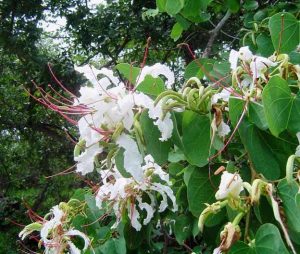
Bauhinia petersiana. Photo: Bart Wursten. Source: Flora of Zimbabwe
Maytenus heterophylla lived up to its name with leaves indeed variable, as were the leaves of Cassine transvaalensis which were growing abundantly, and some very large too. Their smooth grey white trunks contrasted markedly with rough barked neighbours. Less so with a fine Securidace longepedunculata. Its semi smooth bark, also light but slightly grainy, were damaged, showed the yellow wood underneath. Pale, smooth barked Strychnos potatorum held a few leaves and some offered branches full of the small black fruit to the sky. Phil reminded us all how far from edible these are whereas the earlier find of ripe large fruit on a leafless Strychnos spinosa had allowed those who would, to taste the monkey orange! And monkeys do eat them, we know. And what about the joy of the Combretum erythrophyllum leaning invitingly across the sand and pools? Some were coming into sticky green bud, others with old leaves tinting into ‘pale and hectic red” before August winds drive them away and some carrying masses of light coloured 4 winged fruit which are the smallest of the combretum seeds. Elsewhere were Combretum collinum, also large trees with attractive trunks, large leaves and fairly large fruit, brown with a rusty sheen. C.apiculatum leaves showed the characteristic sharply curved point. C.mollis still wore soft shades of rainbow green-orange to red and maroon. Combretum hereroense, the mouse eared combretum, sometimes softly furry but sometimes not, carried a few two toned fruit. C.imberbe, light grey leaves and hardy, the leadwood, withstands termite attacks and burns to a white ash. Later we also saw Combretum zeyheri, almost leafless, but bearing its decorative, light coloured fruit, largest of all the combretum fruits.
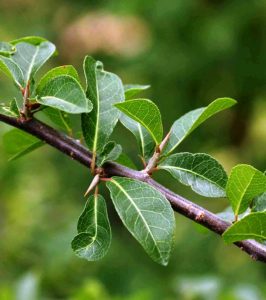
Commiphora pyracanthoides Photo: Bart Wursten. Source: Flora of Zimbabwe
After lunch we walked to see the uncommon Ficus nigropunctata growing with the support of other trees, holding a few of its tiny fruit high over our heads, its bark a dull maroon and lenticels spotted. Olax dissitiflora drooped prettily, perhaps too late in the season for the orangy brown leaves, crushed, produce the chemical re-action that gives off the cyanide smell. Familiar to us in Chegutu was the bare green trunk of Commiphora pyracanthoides peeling in smallish flakes. Not as small, though, as the flakes of C.africana with which in its leafless stage it could have been confused. A very large marula, Sclerocarya birrea, proved to be female, for fallen fruit lay all around. Nearby a fair sized Euphorbia ingens overshadowed angular stemmed Grewia flavescens and round stemmed G.monticola, Gardenia ternifolia, its bark powdering our fingers, Xanthoxylum chalybaeum with knobbly trunk and one remaining prickle backed leafy twig, and Balanites aegyptica, ferocious with its spines famed as molluscicide and fish poison.
And so to a final stroll over cracking dry clay through the stand of mopane trees, so special to most of us. We had counted at least 85 species but it is the large trees that stay in our minds, the two and a bit-person-spanned Kigelia africana, the Diospyros mespiliformis, the Acacia goetzei and galpinii the Combretums on the river bank, the marula and the mopane, and it was good to share this with old and new friends – so thank you all for your company and enthusiasm.
-Ann Bianchi
ROOTNOTE Tree Life No 82, December 1986 : On the edge of a tobacco land left fallow for +- 7 years, but well grazed by landowner’s cattle, and protected from fire, Terminalia sericea have seeded and sprouted like weeks, many are almost 12ft high. Elsewhere on Burnbank we have seen how quickly they can reach reasonable size. It is a useful tree for posts and huts so is it not one that could be promoted??
-Ann Bianchi
ROOTNOTE Dr. G W Reynolds visited Kenya, Ethiopia and Somalia during August to October 1953 and amongst his writings this extract appears :
Black crows are invariably found where Commiphora trees grow. Three of them perched in the branches of the dead tree above my bed and caw cawed their morning’s greetings three times before flying off to another tree. At breakfast I threw some breadcrumbs on the ground and the crows flew down to snatch the irresistible snacks so temptingly offered. I can think of no more fascinating place to have breakfast than to be surrounded by whistling thorn trees and Commiphoras, with a wind blowing, in the cool of the early morning. As the wind increased and decreased in speed the pitch of the whistling in the thorn trees rose and fell in responsive rhythm. The whistling is caused by the wind blowing through the holes in the galls on the thorns and although these holes may vary in size and produce different notes simultaneously, the resultant chorus is always melodious and harmonious. I could sit and listen to these anthems of the bush for hours on end.
-Dick Hicks Chairman


